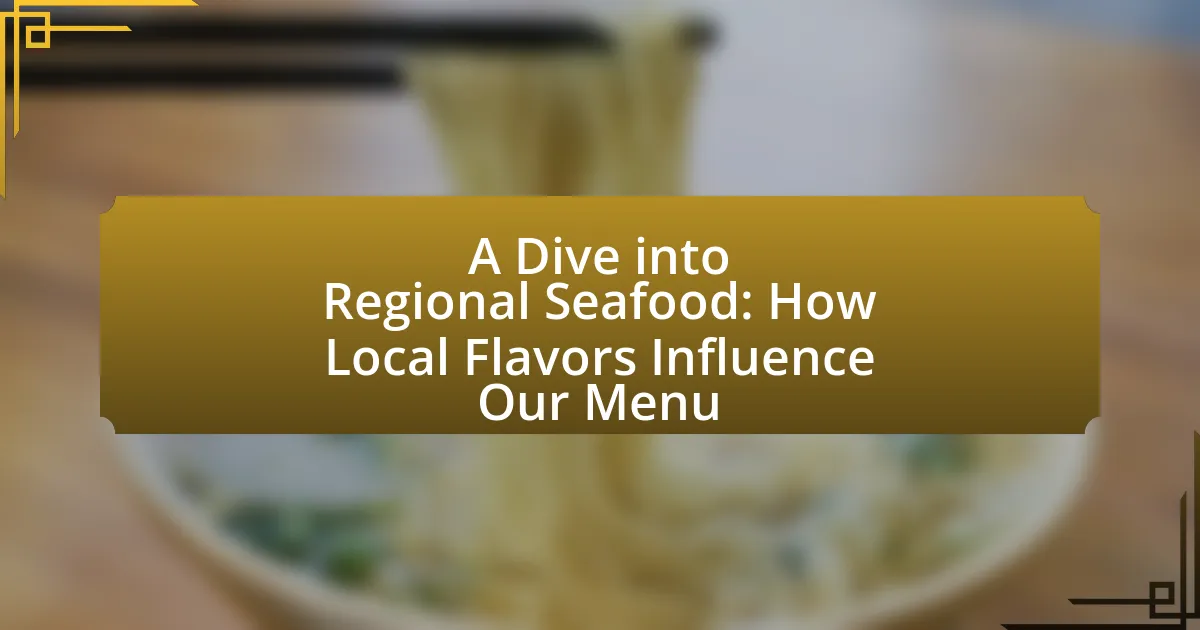Regional seafood encompasses fish and shellfish sourced from specific geographic areas, highlighting local species and sustainable fishing practices. This article explores the significance of regional seafood in supporting local economies, promoting biodiversity, and enhancing culinary experiences through local flavors and preparation methods. It examines how geography influences seafood availability, the environmental benefits of sourcing locally, and the challenges faced in ensuring sustainable practices. Additionally, it discusses the impact of cultural traditions on seafood preparation and offers best practices for chefs to incorporate regional seafood into their menus effectively.

What is Regional Seafood and Why is it Important?
Regional seafood refers to fish and shellfish that are sourced from specific geographic areas, emphasizing local species and sustainable fishing practices. This concept is important because it supports local economies, promotes biodiversity, and reduces the carbon footprint associated with transporting seafood over long distances. For instance, consuming regional seafood can lead to fresher products, as they are often harvested and sold within the same area, ensuring higher quality and better taste. Additionally, prioritizing regional seafood helps maintain the health of local marine ecosystems by encouraging responsible fishing practices that are tailored to the specific environmental conditions of the region.
How do local flavors shape the seafood we consume?
Local flavors significantly shape the seafood we consume by influencing preparation methods, seasoning choices, and presentation styles. For instance, coastal regions often incorporate indigenous spices and herbs, such as cilantro in Latin American cuisines or lemongrass in Southeast Asian dishes, which enhance the natural taste of seafood. Additionally, traditional cooking techniques, like grilling in Mediterranean cultures or steaming in Asian cuisines, further define the flavor profiles of seafood dishes. This regional specificity is supported by studies showing that local culinary practices and available ingredients directly impact the taste and appeal of seafood, making it a reflection of cultural identity and local resources.
What are the defining characteristics of regional seafood?
Regional seafood is characterized by its sourcing from local waters, reflecting the unique ecological conditions and cultural practices of a specific area. This seafood often showcases distinct flavors and preparation methods that are influenced by local culinary traditions. For example, the seafood from the Pacific Northwest, such as salmon and Dungeness crab, is often prepared with indigenous ingredients like cedar and wild herbs, while New England seafood features clam chowder and lobster rolls, highlighting the region’s maritime heritage. The freshness of regional seafood is also a defining trait, as it is typically harvested and consumed within a short time frame, ensuring optimal taste and quality.
How does geography influence seafood availability?
Geography significantly influences seafood availability by determining the types of marine ecosystems present in a region. Coastal areas with rich biodiversity, such as coral reefs and estuaries, support a wide variety of fish and shellfish species, while inland regions may have limited access to fresh seafood. For instance, countries with extensive coastlines, like Norway and Japan, have access to abundant seafood resources due to their proximity to nutrient-rich waters. Additionally, ocean currents and water temperatures affect the distribution of marine species; warmer waters may support different species compared to colder regions. This geographical variation leads to diverse seafood offerings that reflect local ecosystems and fishing practices.
Why should we consider local seafood in our menus?
Considering local seafood in menus enhances freshness and supports sustainability. Local seafood is often caught and delivered within hours, ensuring superior quality and flavor compared to imported options. Additionally, sourcing seafood locally reduces carbon footprints associated with transportation, contributing to environmental sustainability. According to the National Oceanic and Atmospheric Administration (NOAA), supporting local fisheries helps maintain healthy ecosystems and promotes economic stability in coastal communities. Thus, incorporating local seafood not only elevates culinary experiences but also fosters responsible sourcing practices.
What are the environmental benefits of sourcing local seafood?
Sourcing local seafood significantly reduces the carbon footprint associated with transportation. By minimizing the distance seafood travels from ocean to plate, local sourcing decreases greenhouse gas emissions linked to long-distance shipping. Additionally, local seafood supports sustainable fishing practices, as regional fisheries are often more closely monitored and regulated, leading to healthier fish populations and ecosystems. According to the National Oceanic and Atmospheric Administration (NOAA), local fisheries can contribute to the preservation of marine biodiversity by promoting responsible harvesting methods. This approach not only protects aquatic habitats but also enhances the resilience of local ecosystems against climate change impacts.
How does local seafood support community economies?
Local seafood supports community economies by creating jobs, boosting local businesses, and enhancing tourism. The fishing industry provides employment opportunities for local fishermen, processors, and distributors, which directly contributes to the economic stability of coastal communities. For instance, in the United States, the commercial fishing industry supports over 1.5 million jobs and generates approximately $200 billion in sales annually. Additionally, local seafood markets and restaurants benefit from sourcing fresh, regional products, which attracts consumers who prefer to support local economies. This preference can lead to increased foot traffic and sales, further stimulating economic growth. Moreover, regions known for their seafood often see a rise in tourism, as visitors seek authentic culinary experiences, thereby injecting additional revenue into the community.

How Do Regional Flavors Influence Seafood Dishes?
Regional flavors significantly influence seafood dishes by incorporating local ingredients, cooking techniques, and cultural traditions. For instance, coastal regions often utilize herbs, spices, and sauces that reflect their agricultural products and historical trade routes. In the Mediterranean, seafood is commonly paired with olive oil, garlic, and fresh herbs, showcasing the area’s agricultural bounty. In contrast, Southeast Asian seafood dishes frequently feature bold flavors from lemongrass, chili, and coconut milk, which are staples in the region’s cuisine. This integration of local flavors not only enhances the taste but also preserves cultural identity, as seen in dishes like New England clam chowder, which reflects the region’s maritime history and local dairy farming.
What are some examples of regional seafood dishes?
Examples of regional seafood dishes include clam chowder from New England, paella from Spain, and sushi from Japan. Clam chowder, a creamy soup made with clams, potatoes, and onions, is a staple in New England cuisine, reflecting the area’s rich maritime history. Paella, originating from Valencia, features rice, saffron, and a variety of seafood such as shrimp and mussels, showcasing the Mediterranean’s diverse marine life. Sushi, a traditional Japanese dish, consists of vinegared rice paired with raw fish and other ingredients, highlighting Japan’s long-standing fishing culture. These dishes exemplify how local ingredients and culinary traditions shape regional seafood offerings.
How do spices and cooking methods vary by region?
Spices and cooking methods vary significantly by region due to local climate, culture, and available ingredients. For instance, Southeast Asian cuisines often utilize bold spices like lemongrass, galangal, and chili, reflecting the region’s tropical climate and agricultural practices. In contrast, Mediterranean cooking emphasizes herbs such as oregano, basil, and thyme, which thrive in its temperate climate and are integral to dishes like pasta and grilled seafood. Additionally, cooking methods differ; grilling is prevalent in coastal regions for seafood, while stewing is common in areas with a focus on heartier ingredients. This regional diversity is supported by historical trade routes that introduced various spices and techniques, shaping local culinary identities.
What role do cultural traditions play in seafood preparation?
Cultural traditions significantly influence seafood preparation by dictating methods, flavors, and presentation styles unique to each region. For instance, in Japan, the practice of sushi-making emphasizes freshness and precision, reflecting the cultural value placed on aesthetics and quality. Similarly, in Mediterranean countries, seafood is often grilled or baked with herbs and olive oil, showcasing local agricultural products and culinary techniques passed down through generations. These traditions not only preserve regional identities but also enhance the sensory experience of seafood dishes, as evidenced by the popularity of traditional recipes that have remained unchanged for centuries.
How can chefs incorporate local flavors into their menus?
Chefs can incorporate local flavors into their menus by sourcing ingredients from nearby farms and fisheries, ensuring freshness and authenticity. Utilizing seasonal produce and regional seafood not only enhances the taste but also supports local economies. For example, chefs in coastal areas can feature fish caught that day, while those in agricultural regions can highlight vegetables and grains unique to their locale. This practice not only reflects the culinary heritage of the area but also resonates with consumers who increasingly prefer locally-sourced food, as evidenced by a 2021 survey indicating that 70% of diners prioritize local ingredients when choosing restaurants.
What are some innovative ways to feature regional seafood?
Innovative ways to feature regional seafood include creating seasonal tasting menus that highlight local catches, utilizing sustainable cooking methods such as sous-vide or smoking, and incorporating seafood into unexpected dishes like tacos or sushi burritos. Seasonal tasting menus allow chefs to showcase the freshest seafood available, which can enhance the dining experience and support local fisheries. Sustainable cooking methods not only preserve the quality of the seafood but also appeal to environmentally conscious consumers. Additionally, integrating seafood into popular formats like tacos or sushi burritos can attract a wider audience and introduce regional flavors in a modern context.
How can seasonal availability affect menu planning?
Seasonal availability significantly impacts menu planning by dictating which ingredients are fresh and at their peak quality. When seafood is in season, it tends to be more abundant, leading to lower prices and better flavor profiles, which can enhance the overall dining experience. For instance, certain fish species like salmon are typically more flavorful and sustainable when sourced during their spawning season. Additionally, utilizing seasonal ingredients aligns with consumer preferences for freshness and supports local fisheries, fostering a sustainable approach to menu development. This practice not only improves dish quality but also allows restaurants to adapt their offerings based on the changing availability of local seafood, ensuring a dynamic and appealing menu.

What Challenges Exist in Sourcing Regional Seafood?
Sourcing regional seafood faces several challenges, including sustainability concerns, regulatory compliance, and supply chain limitations. Sustainability issues arise from overfishing and habitat destruction, which threaten fish populations and ecosystems. Regulatory compliance is complicated by varying local, state, and federal laws that govern fishing practices, making it difficult for suppliers to navigate the legal landscape. Additionally, supply chain limitations can result from seasonal availability and geographic constraints, impacting the consistency and reliability of seafood sourcing. For instance, the National Oceanic and Atmospheric Administration (NOAA) reports that certain fish stocks are at risk, highlighting the need for responsible sourcing practices.
What are the sustainability concerns related to regional seafood?
Sustainability concerns related to regional seafood include overfishing, habitat destruction, and the impact of climate change on marine ecosystems. Overfishing depletes fish populations faster than they can reproduce, threatening biodiversity and the livelihoods of communities dependent on fishing. Habitat destruction, such as the damage caused by trawling, disrupts marine environments and affects various species. Additionally, climate change alters ocean temperatures and acidity, impacting fish migration patterns and breeding cycles. According to the Food and Agriculture Organization, approximately 34% of global fish stocks are overfished, highlighting the urgency of addressing these sustainability issues.
How can overfishing impact local seafood supplies?
Overfishing significantly reduces local seafood supplies by depleting fish populations faster than they can reproduce. This unsustainable practice leads to a decline in the availability of key species, which directly impacts local fisheries and the communities that rely on them for income and food security. For instance, according to the Food and Agriculture Organization, approximately 34% of global fish stocks are overfished, which can lead to economic instability in regions dependent on fishing. As fish populations dwindle, local fishermen face reduced catches, resulting in higher prices and limited access to seafood for consumers.
What measures can be taken to ensure sustainable sourcing?
To ensure sustainable sourcing, businesses should implement practices such as establishing partnerships with certified suppliers, utilizing traceability systems, and adhering to environmental standards. Certified suppliers, such as those recognized by the Marine Stewardship Council, demonstrate commitment to sustainable fishing practices, which helps maintain fish populations and ecosystems. Traceability systems allow companies to track the origin of seafood, ensuring it comes from sustainable sources and enabling transparency in the supply chain. Adhering to environmental standards, such as those set by the Food and Agriculture Organization, further reinforces sustainable sourcing by promoting responsible resource management and minimizing ecological impact.
How do regulations affect the sourcing of regional seafood?
Regulations significantly impact the sourcing of regional seafood by establishing guidelines that govern fishing practices, sustainability, and trade. These regulations, such as quotas, size limits, and seasonal restrictions, are designed to protect fish populations and marine ecosystems. For instance, the Magnuson-Stevens Fishery Conservation and Management Act in the United States sets annual catch limits to prevent overfishing, thereby influencing which seafood can be sourced regionally. Compliance with these regulations ensures that seafood is harvested sustainably, which can affect availability and pricing in local markets.
What are the key regulations governing seafood sourcing?
The key regulations governing seafood sourcing include the Magnuson-Stevens Fishery Conservation and Management Act, the Lacey Act, and the Seafood Import Monitoring Program. The Magnuson-Stevens Act establishes the framework for the conservation and management of fishery resources in U.S. federal waters, ensuring sustainable fishing practices. The Lacey Act prohibits the trade of wildlife, fish, and plants that have been taken in violation of any law, thus promoting legal sourcing. The Seafood Import Monitoring Program requires importers to provide detailed information about the seafood they bring into the U.S., aimed at combating illegal, unreported, and unregulated fishing. These regulations collectively ensure that seafood sourcing is conducted sustainably and legally, protecting marine ecosystems and promoting responsible consumption.
How can chefs navigate these regulations effectively?
Chefs can navigate regulations effectively by staying informed about local seafood sourcing laws and guidelines. This involves regularly consulting resources such as the National Oceanic and Atmospheric Administration (NOAA) and local health departments to understand compliance requirements. Additionally, chefs can participate in workshops and training sessions focused on sustainable seafood practices, which often cover regulatory updates. Engaging with local fisheries and seafood suppliers also provides insights into best practices and compliance, ensuring that chefs are aligned with both legal standards and sustainability efforts.
What are best practices for incorporating regional seafood into menus?
Best practices for incorporating regional seafood into menus include sourcing seafood from local fisheries to ensure freshness and sustainability. Utilizing seasonal seafood not only enhances flavor but also supports local economies and reduces carbon footprints associated with transportation. Additionally, highlighting the origin of the seafood on the menu can educate customers and promote regional pride. Research indicates that menus featuring locally sourced ingredients can increase customer satisfaction and loyalty, as consumers increasingly prefer sustainable dining options.

Leave a Reply